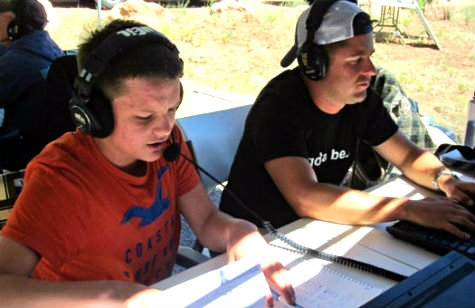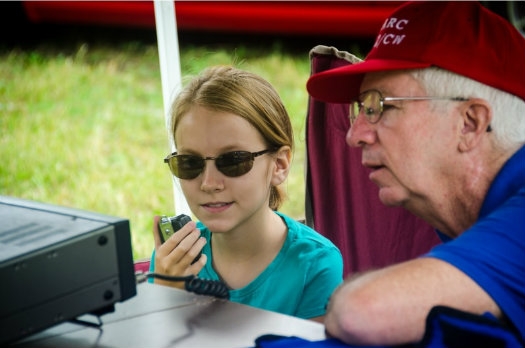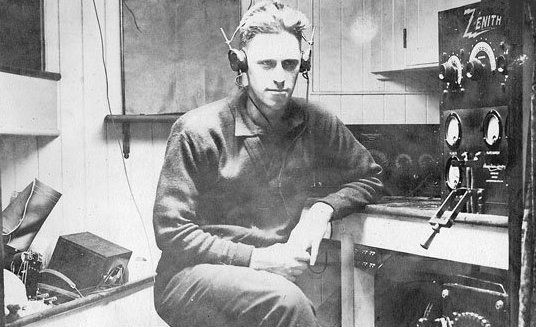What's happening at BCARA

What is Ham Radio? (click here)
What is Ham Radio? Amateur Radio (ham radio) is a popular hobby and service that brings people, electronics and communication together. People use ham radio to talk across town, around the world, or even into space, all without the Internet or cell phones. It's fun, social, educational, and can be a lifeline during times of need. You can set up a ham radio station anywhere! In a field... ...at a club station.... ...or at home. Although Amateur Radio operators get involved for many reasons, they all have in common a basic knowledge of radio technology and operating principles,...

Why should I get licensed? (click here)
Why should I get licensed? Before you can get on the air, you need to be licensed and know the rules to operate legally. US licenses are good for 10 years before renewal and anyone may hold one except a representative of a foreign government. In the US there are three license classes—Technician, General and Extra. Technician License The Technician class license is the entry-level license of choice for most new ham radio operators. To earn the Technician license requires passing one examination totaling 35 questions on radio theory, regulations and operating practices. The license gives access to all Amateur Radio frequencies above...

Ham Radio History (click here)
In 1873, James Clerk Maxwell presented his theory of the electromagnetic field. In 1901 Guglielmo Marconi communicated across the Atlantic with a radio device using high power and giant antennas. To curb interference, Congress approved the Radio Act of 1912, which required amateurs to be licensed and restricted to the single wavelength of 200 meters. In 1914 the American Radio Relay League was founded by Hiram Percy Maxim, who found that messages could be sent more reliably over long distances if relay stations were organized. Transatlantic transmitting and receiving tests began in 1921 and by July 1960 the first two-way contact...

Your First Station (click here)
Your Amateur Radio station may change, but you have to start somewhere, right? Here are some fundamentals that all Amateur Radio stations have in common: Transceiver Power Supply Antenna System The Transceiver Selecting your transceiver will largely depend on how much you want to spend and what you hope to do. If you want to explore long-distance contacts on the HF bands, you’ll need an HF transceiver. If you are interested in chatting with local friends on the VHF or UHF bands, look for a VHF+ FM transceiver. Build Your Own Radio Most hams buy their radios factory assembled,...
-
What is Ham Radio? (click here)
-
Why should I get licensed? (click here)
-
Ham Radio History (click here)
-
Your First Station (click here)
Headlines

Educating, Encouraging and Entertaining - Amateur Radio and BCARA
2024 officers : Pres. Richard N8MQO, V.P. David KX8U,
Sec. KB8QKJ Frank, Treas. W8XLV Erik,
Board members: Richard KC8RP, and Matt K8KMB
...................................................................................................
APRS for Everyone!
Here is the link to the file presented at the October meeting by David, KX8U
----------------------------------------------------------------------------------------------------------
FIELD DAY 2025
BCARA will be participating in the ARRL Field Day.
Field Day is always the fourth full weekend of June, beginning at 1800 UTC Saturday and running through 2059 UTC Sunday.
We will be at Butler County Sportsmen Rifle & Pistol Club
2131 Millville Ave, Hamilton, OH 45013
This is open to the public Come and learn about amateur radio as we make radio contacts across the county and around the world!
There is another amateur radio license exam coming up. Click the link Test Session link on the left side of this screen for more detaisl
Have you completed an RF exposure assessment
on your amateur radio station?
Click the link below.
RF Exposure Calculation Information
BCARA meetings are the 2nd Monday each month at 7pm. and are held at:
This is located on the corner of Morris Rd and Millikin Rd. Near Butler Tech. Wheelchair accessible.
We strive to provide education topics that the membership wants. Each meeting has a short business section and then into a program or training segment. Topics such as basic electronics, emergency communications, or...
Join us in person or on the air. 146.700 + pl 123 FM or System Fusion digital.
Butler County Health Department
Please come and join us, even if you are not yet...an Amateur Radio Operator, You are welcome to our events and meetings. Our group is fun, helpful and we enjoy fellowship with each other. Our monthly meetings usually include education topics or presentations. If you need assistance getting licensed, BCARA has many members and resources to help you get there. Please visit us soon. 73
BCARA email reflector. To sign-up or make changes to your account click here: http://mailman.qth.net/mailman/listinfo/bcara
Repeater site antennas
Member Login
Main Menu
Who's Online
We have 18 guests and no members online
Meetings
ARRL News
American Radio Relay League | Ham Radio Association and Resources
The American Radio Relay League (ARRL) is the national association for amateur radio, connecting hams around the U.S. with news, information and resources.-
The ARRL Solar Report
Spaceweather.com reports solar activity was at low levels with only C-class flares observed. The largest flare during the period was a C8.9 from an unnumbered region beyond the east limb at S13. This region was also responsible for the majority of the remaining flares alongside Regions 4136 and 4137. An approximate M2 was observed by Solar Orbiter at 10/1326 UTC just beyond the east limb, bri...
-
Great Numbers Stacking Up for 2025 ARRL Field Day
The numbers for 2025 ARRL Field Day continue to grow. As of today, July 10, 3227 entries have been received and each day the list gets bigger, according to ARRL Contest Program Manager Paul Bourque, N1SFE. “Get those entries in!” he encouraged. The deadline is July 29. It was a big year for ARRL Field Day on social media. 260 public posts across several platforms used the hashtag #ARRLFD. That ...
-
Special Call Signs for this year’s International Amateur Radio Union (IARU) Contest
-
'Tripp' Owens, N4NTO, Silent Key
Ambrose "Tripp" L. Owens, III, N4NTO, passed away on July 4, 2025. He was 57 years old. Investigators from the Harnett County Sheriff’s Office in North Carolina believe the cause of death was accidental electrocution but a final determination has not been made. Owens was working with an antenna mast in the Chicora Civil War Cemetery at the Averasboro Battlefield during a Parks on the Air (POTA)...
-
Amateur Radio Volunteers Serving During Texas Floods
Volunteer amateur radio operators serving in the ARRL The National Association for Amateur Radio® (ARRL®) Amateur Radio Emergency Service® (ARES®) are embedded with local served agencies in the areas of central Texas affected by devastating floods.The needs and assignments have been changing, but ARES volunteers are stepping up to the dynamic needs of their communities. “This is a very fluid si...
-
Changes in the ARRL Idaho Section
Don Lynn Jr., ND7L, of Nampa, has been appointed Section Manager of the ARRL Idaho Section effective July 9, 2025. Lynn has served as the Assistant Section Manager since 2019, and the State Government Liaison since 2020. He is an ARRL Life Member.Lynn will serve the remainder of a term expiring September 30, 2026. He replaces Dan Marler, K7REX, who resigned from the position due to health issue...
